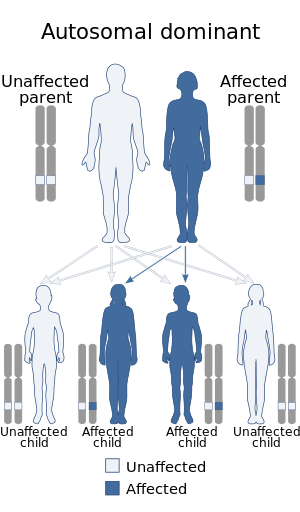Holt-Oram Syndrome
| Holt-Oram syndrome | |
|---|---|
 |
|
| Holt-Oram syndrome has an autosomal dominant pattern of inheritance | |
| Classification and external resources | |
| Specialty | medical genetics |
| ICD-10 | Q87.2 |
| OMIM | 142900 |
| DiseasesDB | 5988 |
| eMedicine | med/2940 ped/1021 |
| GeneReviews | |
Holt–Oram syndrome (also called Heart and Hand Syndrome, atrio-digital syndrome, atriodigital dysplasia, cardiac-limb syndrome, heart-hand syndrome type 1, HOS, ventriculo-radial syndrome) is an autosomal dominant disorder that affects bones in the arms and hands (the upper limbs) and may also cause heart problems. The syndrome includes an absent radial bone in the arms, an atrial septal defect, and a first degree heart block.Thalidomide syndrome can produce similar morphology to Holt–Oram syndrome, sufficient to be considered a phenocopy.
All people with this disorder have at least one limb abnormality that affects bones in the wrist (carpal bones). Often, these wrist bone abnormalities can be detected only by X-ray. Affected individuals may have additional bone abnormalities that can include polydactyly, a hypoplastic thumb or a Triphalangeal thumb, partial or complete absence of bones in the forearm, an underdeveloped Humerus, and abnormalities that affect the Clavicle and Scapula. Bone abnormalities may affect each arm differently, and the left side can be affected more than the right side. In some cases, only one arm and/or hand is affected.
About 75 percent of individuals with Holt–Oram syndrome have heart problems. The most common problem is a defect in the muscular wall, or septum, that separates the right and left sides of the heart (atria).Atrial septal defects (ASD) are caused by a hole in the septum between the left and right upper chambers of the heart (atria), and ventricular septal defects (VSD) are caused by a hole in the septum between the left and right lower chambers of the heart (ventricles). Sometimes people with Holt–Oram syndrome have cardiac conduction disease, which is caused by abnormalities in the electrical system that coordinates contractions of the heart chambers. Cardiac conduction disease can lead to problems such as a slow heart rate (bradycardia) or a rapid and ineffective contraction of the heart muscles (fibrillation). Cardiac conduction disease can occur along with other heart defects (such as septal defects) or as the only heart problem in people with Holt–Oram syndrome.
...
Wikipedia
